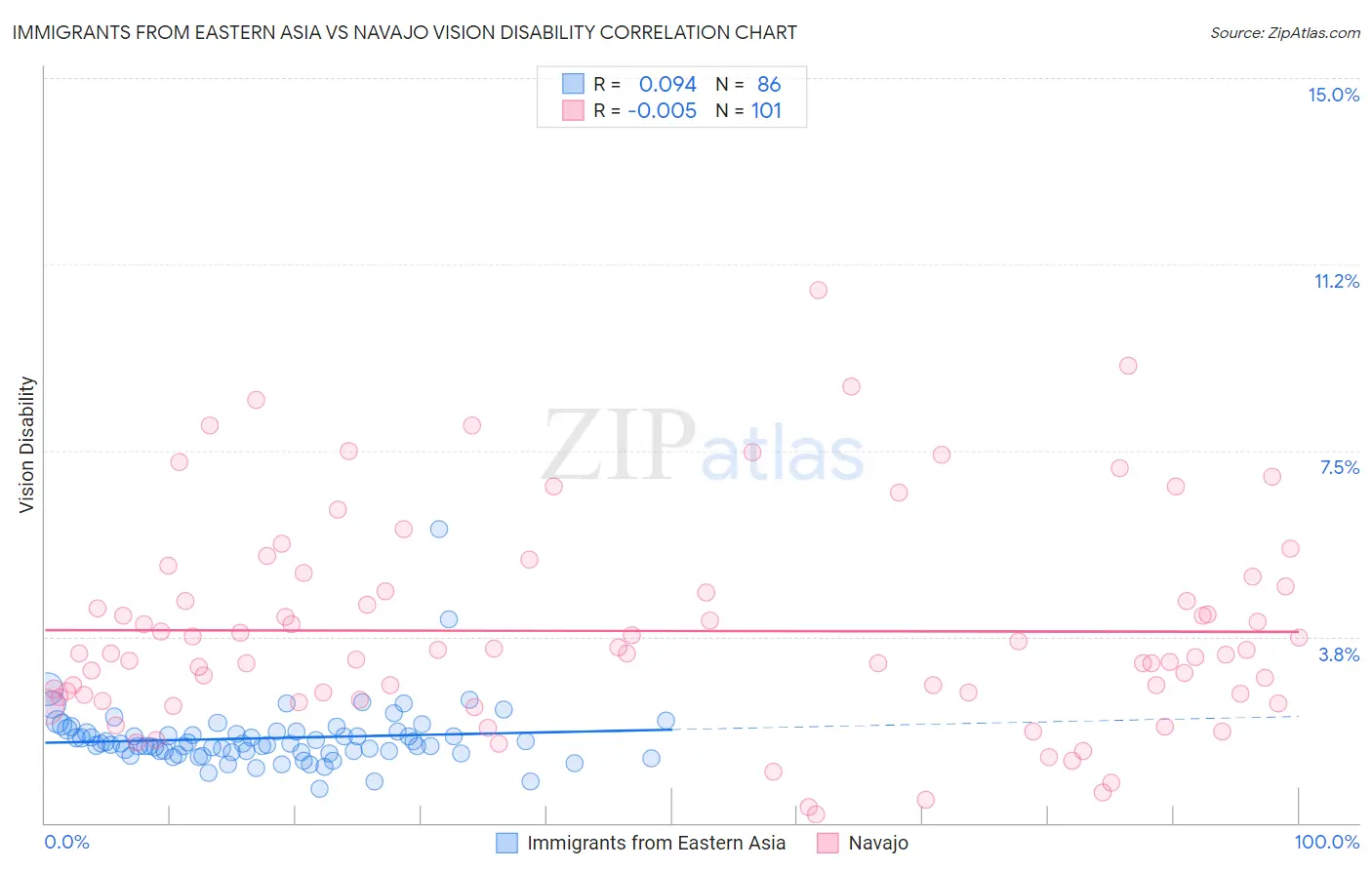Immigrants from Eastern Asia vs Navajo Vision Disability
COMPARE
Immigrants from Eastern Asia
Navajo
Vision Disability
Vision Disability Comparison
Immigrants from Eastern Asia
Navajo
1.8%
VISION DISABILITY
100.0/ 100
METRIC RATING
13th/ 347
METRIC RANK
3.1%
VISION DISABILITY
0.0/ 100
METRIC RATING
335th/ 347
METRIC RANK
Immigrants from Eastern Asia vs Navajo Vision Disability Correlation Chart
The statistical analysis conducted on geographies consisting of 499,136,938 people shows a slight positive correlation between the proportion of Immigrants from Eastern Asia and percentage of population with vision disability in the United States with a correlation coefficient (R) of 0.094 and weighted average of 1.8%. Similarly, the statistical analysis conducted on geographies consisting of 224,647,940 people shows no correlation between the proportion of Navajo and percentage of population with vision disability in the United States with a correlation coefficient (R) of -0.005 and weighted average of 3.1%, a difference of 71.7%.

Vision Disability Correlation Summary
| Measurement | Immigrants from Eastern Asia | Navajo |
| Minimum | 0.68% | 0.16% |
| Maximum | 5.9% | 10.7% |
| Range | 5.2% | 10.6% |
| Mean | 1.7% | 3.9% |
| Median | 1.6% | 3.4% |
| Interquartile 25% (IQ1) | 1.4% | 2.6% |
| Interquartile 75% (IQ3) | 1.8% | 4.7% |
| Interquartile Range (IQR) | 0.40% | 2.2% |
| Standard Deviation (Sample) | 0.65% | 2.1% |
| Standard Deviation (Population) | 0.65% | 2.1% |
Similar Demographics by Vision Disability
Demographics Similar to Immigrants from Eastern Asia by Vision Disability
In terms of vision disability, the demographic groups most similar to Immigrants from Eastern Asia are Immigrants from Korea (1.8%, a difference of 0.080%), Immigrants from China (1.8%, a difference of 0.15%), Immigrants from Israel (1.8%, a difference of 0.31%), Immigrants from Bolivia (1.8%, a difference of 0.57%), and Indian (Asian) (1.8%, a difference of 1.0%).
| Demographics | Rating | Rank | Vision Disability |
| Immigrants | Iran | 100.0 /100 | #6 | Exceptional 1.8% |
| Immigrants | South Central Asia | 100.0 /100 | #7 | Exceptional 1.8% |
| Iranians | 100.0 /100 | #8 | Exceptional 1.8% |
| Immigrants | Singapore | 100.0 /100 | #9 | Exceptional 1.8% |
| Immigrants | Hong Kong | 100.0 /100 | #10 | Exceptional 1.8% |
| Immigrants | Israel | 100.0 /100 | #11 | Exceptional 1.8% |
| Immigrants | Korea | 100.0 /100 | #12 | Exceptional 1.8% |
| Immigrants | Eastern Asia | 100.0 /100 | #13 | Exceptional 1.8% |
| Immigrants | China | 100.0 /100 | #14 | Exceptional 1.8% |
| Immigrants | Bolivia | 100.0 /100 | #15 | Exceptional 1.8% |
| Indians (Asian) | 100.0 /100 | #16 | Exceptional 1.8% |
| Burmese | 100.0 /100 | #17 | Exceptional 1.8% |
| Bolivians | 100.0 /100 | #18 | Exceptional 1.9% |
| Immigrants | Sri Lanka | 100.0 /100 | #19 | Exceptional 1.9% |
| Asians | 100.0 /100 | #20 | Exceptional 1.9% |
Demographics Similar to Navajo by Vision Disability
In terms of vision disability, the demographic groups most similar to Navajo are Alaskan Athabascan (3.1%, a difference of 0.16%), Dutch West Indian (3.2%, a difference of 0.19%), Chickasaw (3.2%, a difference of 1.1%), Cheyenne (3.1%, a difference of 1.7%), and Tsimshian (3.2%, a difference of 1.8%).
| Demographics | Rating | Rank | Vision Disability |
| Yuman | 0.0 /100 | #328 | Tragic 3.0% |
| Apache | 0.0 /100 | #329 | Tragic 3.0% |
| Colville | 0.0 /100 | #330 | Tragic 3.0% |
| Central American Indians | 0.0 /100 | #331 | Tragic 3.0% |
| Seminole | 0.0 /100 | #332 | Tragic 3.1% |
| Cajuns | 0.0 /100 | #333 | Tragic 3.1% |
| Cheyenne | 0.0 /100 | #334 | Tragic 3.1% |
| Navajo | 0.0 /100 | #335 | Tragic 3.1% |
| Alaskan Athabascans | 0.0 /100 | #336 | Tragic 3.1% |
| Dutch West Indians | 0.0 /100 | #337 | Tragic 3.2% |
| Chickasaw | 0.0 /100 | #338 | Tragic 3.2% |
| Tsimshian | 0.0 /100 | #339 | Tragic 3.2% |
| Creek | 0.0 /100 | #340 | Tragic 3.2% |
| Kiowa | 0.0 /100 | #341 | Tragic 3.3% |
| Choctaw | 0.0 /100 | #342 | Tragic 3.3% |